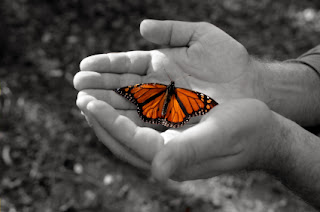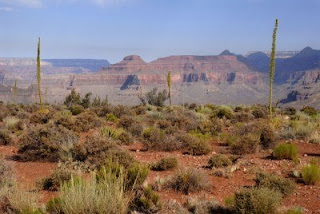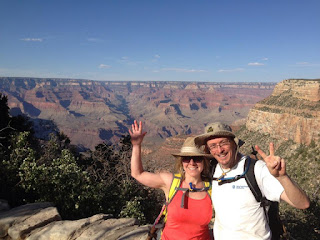WARNING: DO NOT
attempt to hike from the canyon rim to the river and back in one day. Each year
hikers suffer serious illness or death from exhaustion.
It was on my bucket list, “See the Grand Canyon.” But, I
didn’t want to see it from the South rim like a middle-aged tourist starting to
slow down. In spite of the warning, I wanted a challenge – to see, hear, feel
and consume the canyon as the adventurer I’d like to think I am – a modern-day Viking.
At 52, I had found myself, like many women my age, modifying
physical activities in concession to fear or injuries: water and downhill
skiing were too dangerous; running beat up hips and knees; overnight camping in
a tent – too uncomfortable. At the gym I clung to the same ritual of treadmill,
stair climber, then weights – lulled by the familiar.
As frightening as that canyon warning was, I didn’t want to not do it and admit I was forever
closed-off to adventure and growth, the sort that comes from pushing physical
limits. The canyon offered a challenge to the complacency of age and routine
and, I was to find, much more.
The original plan had been to hike down in one day, stay at
Phantom Ranch in the bottom for the night, then hike back up the next day. But
accommodations at the ranch fill up a year in advance. Passes to tent camp at
Bright Angel campground were also long gone.
My husband Dave was dubious, but descriptions of supplies
and fitness levels needed to complete the hike reassured him. Up for an
adventure himself, he got on board, and soon packages started arriving from
Amazon with things like Camelbak hydration packs and a case of Clif Bars.
We started hitting the gym harder than normal and decided
the stair climber might be the best thing to prepare us for all those steps.
Dave daily put in an hour on the stair climber – me, usually a half hour,
occasionally a full hour. Did I mention the hike was estimated to take 12 hours
round trip?
Neither of us had given footwear much thought (footwear,
shmootwear!). Dave had some steel-toed boots from work he thought were
appropriate. I chose Keen All-Terrain sandals, in hindsight about as
appropriate for the canyon as red stilettos. Both of us would have been in a vortex
of pain had we continued on that path.
For weeks my dreams were anxious – filled with images of dry
landscapes and falling off sheer precipices. The thought of calling it off
occurred many times. This didn’t have to be undertaken and what exactly was I
proving? At my age, did I really need to take a treacherous hike we were barely
prepared for?
We arrived in Arizona to stay with my brother Greg and his
family five days before the canyon. Greg, well aware of the dangers of
high-altitude hiking in the heat, took us on three killer climbs to prepare us
for the rigors of our adventure. Our first trek up Black Mountain had us
sucking wind like Grandma at a polka. Nothing in Buffalo, NY could have
prepared us for the thin air.
While sturdy, my Keen open-air sandals collected stones, dirt
and sand every few steps. Dave’s boots were heavy and increasingly hot. A
subsequent trip to Big 5 Sporting Goods outfitted us with Coleman mid-ankle,
lightweight boots. Two more rigorous hikes further hardened us for the Canyon
ahead, or so we thought.
We rose in our hotel room at 5am the morning of our
adventure, neither of us having slept much. After filling our Camelbaks with
water and food, we powdered our socks, Vasalined our feet and laced up the new
boots. Then, we drove to the main parking lot on the South Rim of the Canyon where
a shuttle bus would take us to the South Kaibab trailhead.
On the bus was a grizzled 60-something park ranger with a
braided Fu-Manchu beard viewing us with a practiced eye. I’m sure our Wonder
Bread whiteness and un-scuffed boots didn’t escape his notice. “How far you
folks hiking today?” “We’re hiking top to bottom in one day” answered Dave.
(crickets) “We recommend against that. You folks know how long that takes?” “We
figure 12 hours or so.” He nodded gravely in agreement and repeated his warning.
Our first view of the Canyon had been spectacular the
previous night, but the hike down South Kaibab continually took our breath
away. The path is stunning and recommended for its panoramic views. It’s also
steep. Deep ruts filled with dust and bracketed by logs formed the steps we
were to become quite familiar with.
Tangled Utah Junipers greeted hikers early on the trail but
vegetation became sparse and desert-like as we descended and the temperature
rose. Spiky agave plants studded the hillsides, some with peculiar flowering
stalks up to 12 feet tall – sending up a swan song before they died.
Our path zig-zagged down sheer cliffs of brick red, sage
green and chalk white. Each turn revealed queer rock formations carved by the
Colorado River eons ago, but what one most noticed was the silence. No wind,
car or tourist noises broke that hollow, cathedral hush. The azure sky was
empty of all but the wispiest clouds and the occasional floating hawk.
As we moved down the path, we encountered a couple of mule
teams coming up the trail loaded with tourists and garbage from the ranch,
their droppings odiferous landmines steaming under the hot canyon sun. Aside
from this, there were surprisingly few hikers along the trail and mostly we
trekked by ourselves.
The old ranger had warned us that injuries were more common
on descent, while exhaustion and dehydration were risks on the ascent. This was
true for us. Within a few hours, Dave’s old knee injury ominously began to act
up. My hips became sore from the pounding of each dusty step.
Walking sticks helped but we further wondered what on Mars we
were doing when we viewed a sign mid-way advising that “Descending the canyon
is optional – ascent is mandatory.” In fact, if you do get sick or stuck on the trail, it costs $4,500 to
get airlifted out in a helicopter.
We caught our first glimpse of the Colorado River about
three hours in at the portentously named Skeleton Point. It was tiny, copper
green and impossibly far away. It looked so refreshing and inviting. Dave
reasoned his knees would not be an issue on the longer ascent and, in an act of faith or
foolishness, we continued down the increasingly steep switchbacks.
Four hours and 7.1 miles from the start, we reached river’s
edge after crossing the Kaibab Suspension Bridge. It was over 100 degrees by
that time – it had been just 42 degrees at the trailhead that morning. I soaked
my hot and swollen feet in the river and dunked my head in clear water cold
enough for an ice cream headache. Then, we hiked the flat half-mile or so to
Phantom Ranch. Any illusions of splendor or luxury were soon dashed.
Designed
by Mary Colter and constructed in 1922, Phantom Ranch lodge is of mostly stone
construction surrounded by rustic cabins. The dining room has long wood benches
and tables with florescent lighting overhead – not much different than the
rough-hewn Girl Scout camps I went to in the 60’s.
We
sucked down the fresh lemonade they sold ($4.99 a glass, but so worth it!) and
ate the contents of our packs – beef jerky, dried mango, Clif bars and trail
mix. After an hour’s rest, we got back on the trail for the arduous uphill
climb.
At
first Bright Angel trail gradually inclines, but then dismayingly descends
while switchbacking up and down near the Colorado. It’s an easier climb up than
the steep Kaibab would have been, which is why it was so much longer.
As
the temperature climbed, my hands began to swell alarmingly. I had not thought
to take my wedding ring off and my fingers were puffing like shiny bratwursts. My
slightly heat-addled brain I reasoned I could flag down the occasional ranger
to cut my ring off if needed. Soaking my head and hands in every icy stream we
encountered felt good, but didn’t help the swelling.
The
risk of dehydration is very real on the uphill. We continually sucked water from
our Camelbaks, their lifeline tubes positioned at our mouths, but did not
urinate once during the 6 ½ hour uphill climb. The intense Arizona sun
evaporated our sweat as soon as it left our bodies.
There
is far more vegetation on Bright Angel Trail than on Kaibab. About 1/3 of the
way up we saw an enormous cottonwood tree – limbs splaying over the trail like
angel’s wings, its shade welcome in the sweltering heat.
As
the winds shifted, we smelled the most intoxicating fragrance – what I later
learned was the flowering cliff rose. It was spicy, sweet and disconcertingly,
given the heat, brought me back to my childhood and the smell of incense in
church at Christmas.
Dave
was right about his knees not hurting, but we felt increasingly fatigued after
three hours, and rested halfway up at Indian Gardens. We refilled our water and
ate the dried, but surprisingly appetizing snacks. The thermometer read 114
degrees but shade
was found, and with my hat over my face I took a short nap.
Refreshed
and encouraged that we were roughly 2/3 of the way through with our ill-advised
adventure we headed off confidently – maybe even cockily – up the trail. The
worst was yet to come.
The
gradual incline behind us was replaced by a steep and relentlessly climbing trail.
Switchback after switchback did not even seem to make a dent in the towering
rise of cliffs above us. Viewing the sheer drop of the Canyon walls I could not
imagine how our path could possibly take us to the top, and pictured a giant
ladder propped upright for the final 1,000 feet.
My
legs began to feel like licorice, back sore from the pack, fingers swollen and
throbbing – this with hours to go. Another warning we had received from a
ranger was “Oh, you won’t die, but the last hour of the hike you’ll wish you
had.” Dave and I trudged grimly on.
We
stopped every 15 minutes or so to chug down water, catch our breath and
appreciate the view. When our eyes met, there was only sympathy and exhaustion,
though Dave could have understandably carped at me for my hare-brained idea. We
were in this together and there was to be no blame. We didn’t even have the
energy to talk, other than the occasional “You’re doing great.”
The
final hour of the hike became a battle of wills. That of the whiny baby girl inside
of me who wanted to cry, rest and complain, or the warrior who had given birth
and raised two children, survived a nasty divorce and built a new life of love
and courage. “If I have survived _______, then I can survive this” kept swirling
in my head like a mantra.
We
were frequently fooled by what appeared to be the end of the trail, but was yet
another heartbreaking switchback. Fresh-as-a-daisy tourists wearing flip-flops
would pass us going down, chatting easily among themselves with no clue as to
the epic drama unfolding before them. I hated them and their fresh legs. I
imagined we looked like zombies with our hollow eyes and sweat and dirt-stained
skin.
At
last, six hours after beginning our climb, a final rise revealed Kolb Studio,
the end of our trail. A crowning surge of adrenaline powered us to the top,
surrounded by tourists. We kissed each other tearfully, unbelievingly and
hugged, leaning on each other for support, then enlisted a Danish tourist to
snap our photo – our swelled hands raised in victory.
I
would not hike the Canyon in one day again but have no regrets. Some part of me
knew it was going to be grueling and bring me to the edge of endurance but was
OK with that. There had been questions unasked, not really wanting to know the
answer, but my unpreparedness enabled me to take an adventure of a lifetime and
pick up what the Old Testament Israelites described as a “stone of
remembrance.”
The
stone I now carry at midlife is tenacity: that white-knuckle attribute which
powers through illness, depression, loss and discouragement – ultimately more
important than either talent or luck.
The
Grand Canyon hike – so physically punishing – also energized and reminded me
that despite my age, I have depths within not yet plumbed – strengths not yet
drawn on, but that may well serve on the sometimes-uphill climb ahead.
















